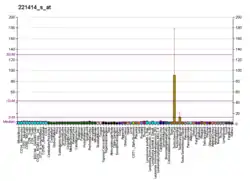DEFB126
Beta-defensin 126 is a protein that in humans is encoded by the DEFB126 gene.[3][4]
| DEFB126 | |||||||||||||||||||||||||
|---|---|---|---|---|---|---|---|---|---|---|---|---|---|---|---|---|---|---|---|---|---|---|---|---|---|
| Identifiers | |||||||||||||||||||||||||
| Aliases | DEFB126, C20orf8, DEFB-26, DEFB26, bA530N10.1, hBD-26, HBD26, defensin beta 126 | ||||||||||||||||||||||||
| External IDs | HomoloGene: 49954 GeneCards: DEFB126 | ||||||||||||||||||||||||
| |||||||||||||||||||||||||
| |||||||||||||||||||||||||
| Orthologs | |||||||||||||||||||||||||
| Species | Human | Mouse | |||||||||||||||||||||||
| Entrez |
| ||||||||||||||||||||||||
| Ensembl |
| ||||||||||||||||||||||||
| UniProt |
| ||||||||||||||||||||||||
| RefSeq (mRNA) |
| ||||||||||||||||||||||||
| RefSeq (protein) |
| ||||||||||||||||||||||||
| Location (UCSC) | Chr 20: 0.14 – 0.15 Mb | n/a | |||||||||||||||||||||||
| PubMed search | [2] | n/a | |||||||||||||||||||||||
| Wikidata | |||||||||||||||||||||||||
| |||||||||||||||||||||||||
Function
Defensins are cysteine-rich cationic polypeptides that are important in the immunologic response to invading microorganisms. The protein encoded by this gene is secreted and is a member of the beta defensin protein family. Beta defensin genes are found in several clusters throughout the genome, with this gene mapping to a cluster at 20p13. The encoded protein is highly similar to an epididymal-specific secretory protein (ESP13.2) from cynomolgus monkey.[4]
It has been suggested that a common variation in the DEFB126 gene generates abnormal mRNA and can somewhat impair fertility.[5]
References
- GRCh38: Ensembl release 89: ENSG00000125788 - Ensembl, May 2017
- "Human PubMed Reference:". National Center for Biotechnology Information, U.S. National Library of Medicine.
- Schutte BC, Mitros JP, Bartlett JA, Walters JD, Jia HP, Welsh MJ, Casavant TL, McCray PB (Feb 2002). "Discovery of five conserved beta -defensin gene clusters using a computational search strategy". Proceedings of the National Academy of Sciences of the United States of America. 99 (4): 2129–33. doi:10.1073/pnas.042692699. PMC 122330. PMID 11854508.
- "Entrez Gene: DEFB126 defensin, beta 126".
- Tollner TL, Venners SA, Hollox EJ, Yudin AI, Liu X, Tang G, Xing H, Kays RJ, Lau T, Overstreet JW, Xu X, Bevins CL, Cherr GN (Jul 2011). "A common mutation in the defensin DEFB126 causes impaired sperm function and subfertility". Science Translational Medicine. 3 (92): 92ra65. doi:10.1126/scitranslmed.3002289. PMC 3736313. PMID 21775668. Lay summary – NY Times.
Further reading
- Rodríguez-Jiménez FJ, Krause A, Schulz S, Forssmann WG, Conejo-Garcia JR, Schreeb R, Motzkus D (Feb 2003). "Distribution of new human beta-defensin genes clustered on chromosome 20 in functionally different segments of epididymis". Genomics. 81 (2): 175–83. doi:10.1016/S0888-7543(02)00034-4. PMID 12620395.
- Perry AC, Jones R, Moisyadi S, Coadwell J, Hall L (Oct 1999). "The novel epididymal secretory protein ESP13.2 in Macaca fascicularis". Biology of Reproduction. 61 (4): 965–72. doi:10.1095/biolreprod61.4.965. PMID 10491631.
- Suzuki Y, Yoshitomo-Nakagawa K, Maruyama K, Suyama A, Sugano S (Oct 1997). "Construction and characterization of a full length-enriched and a 5'-end-enriched cDNA library". Gene. 200 (1–2): 149–56. doi:10.1016/S0378-1119(97)00411-3. PMID 9373149.
- Maruyama K, Sugano S (Jan 1994). "Oligo-capping: a simple method to replace the cap structure of eukaryotic mRNAs with oligoribonucleotides". Gene. 138 (1–2): 171–4. doi:10.1016/0378-1119(94)90802-8. PMID 8125298.
This article is issued from Wikipedia. The text is licensed under Creative Commons - Attribution - Sharealike. Additional terms may apply for the media files.


